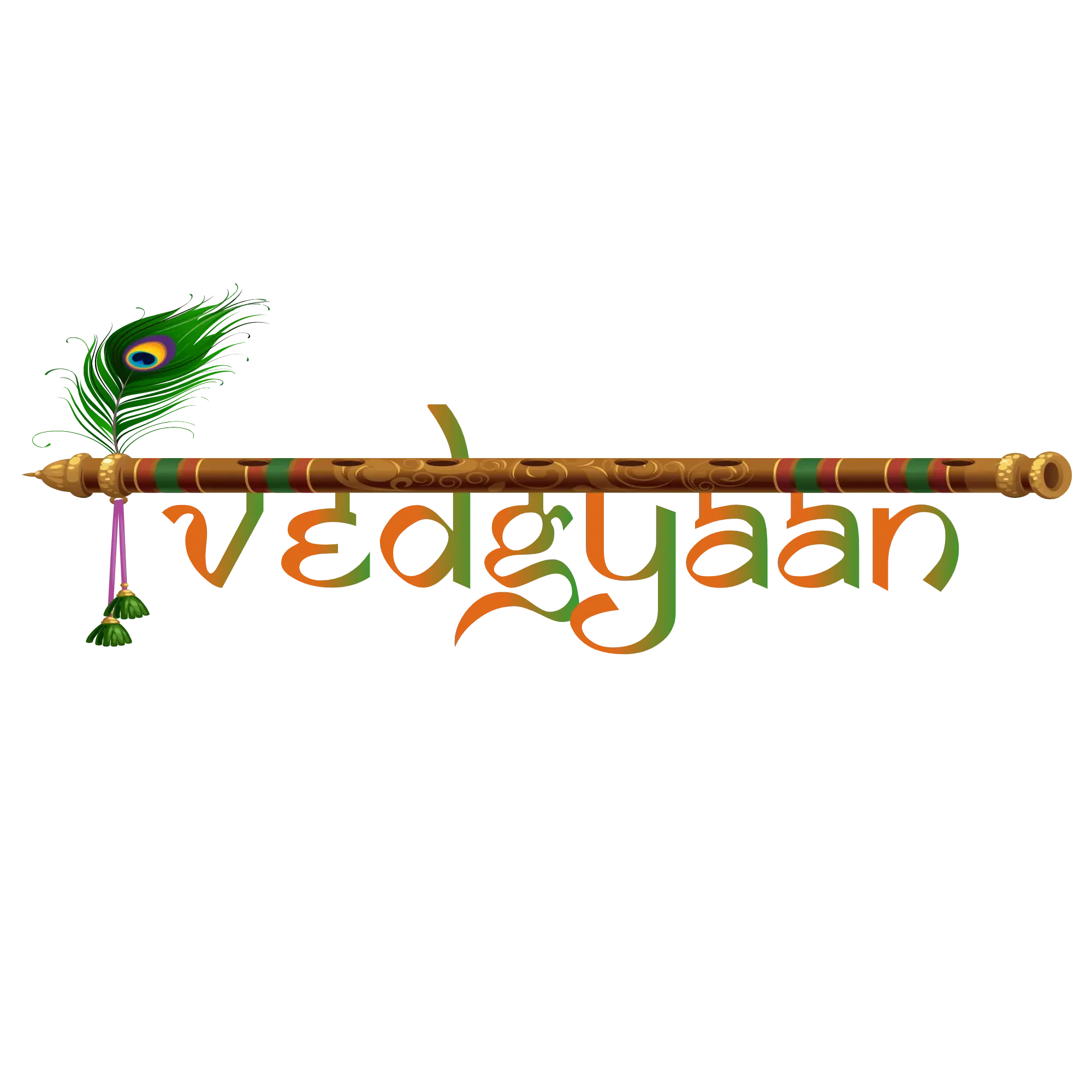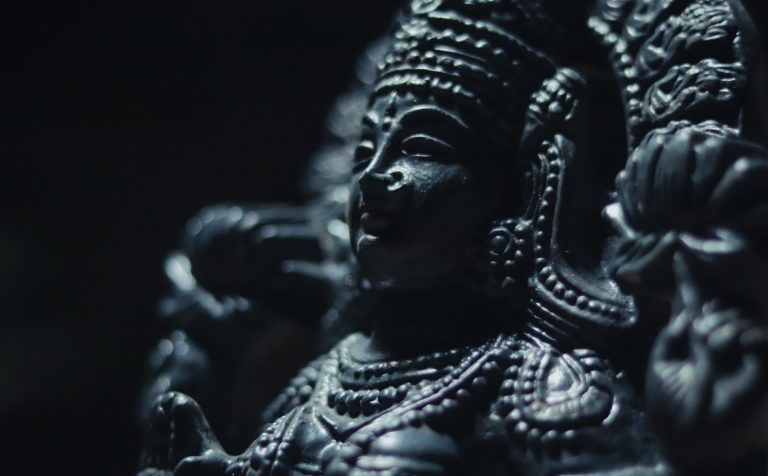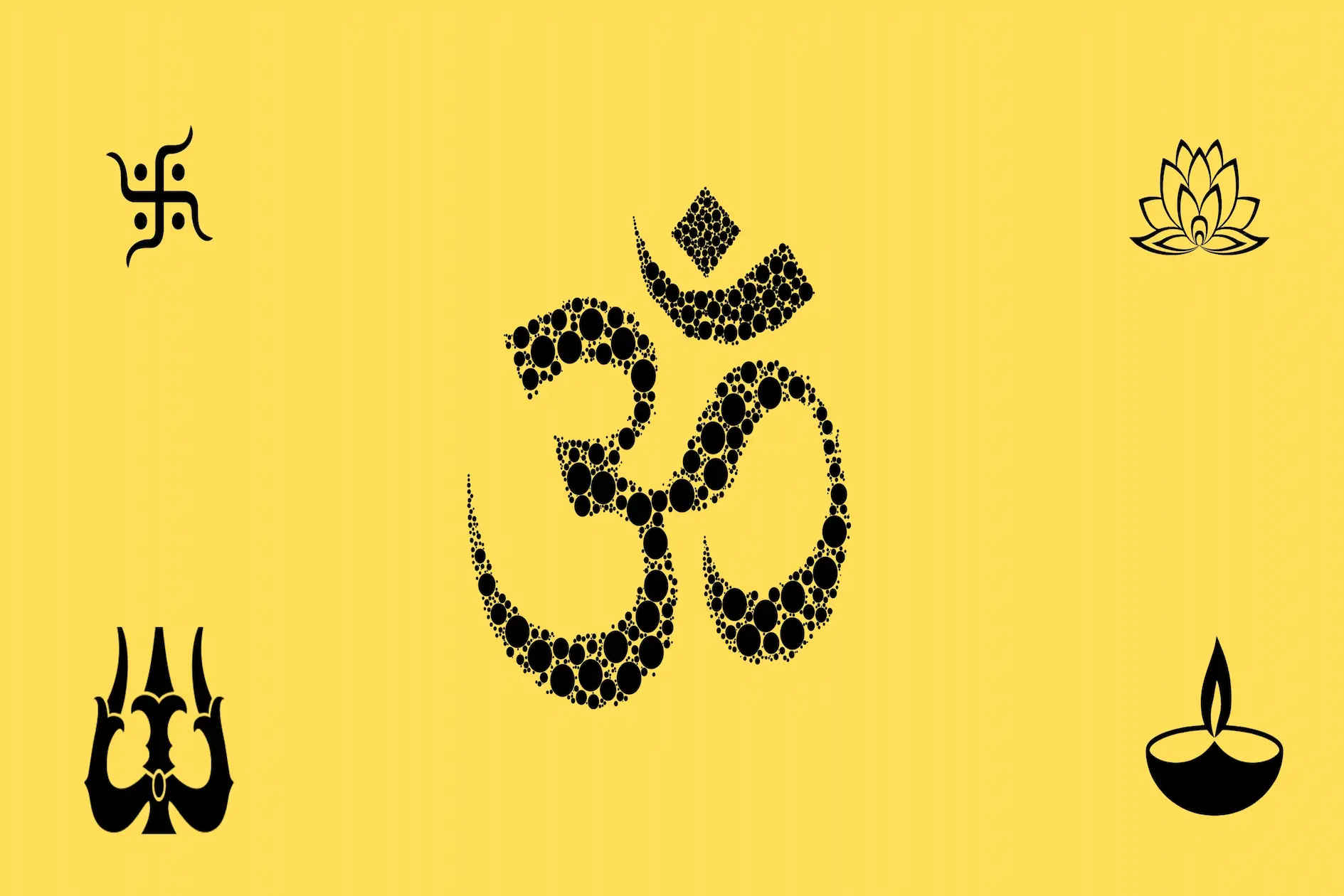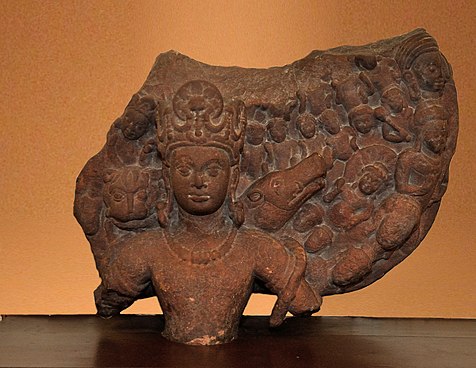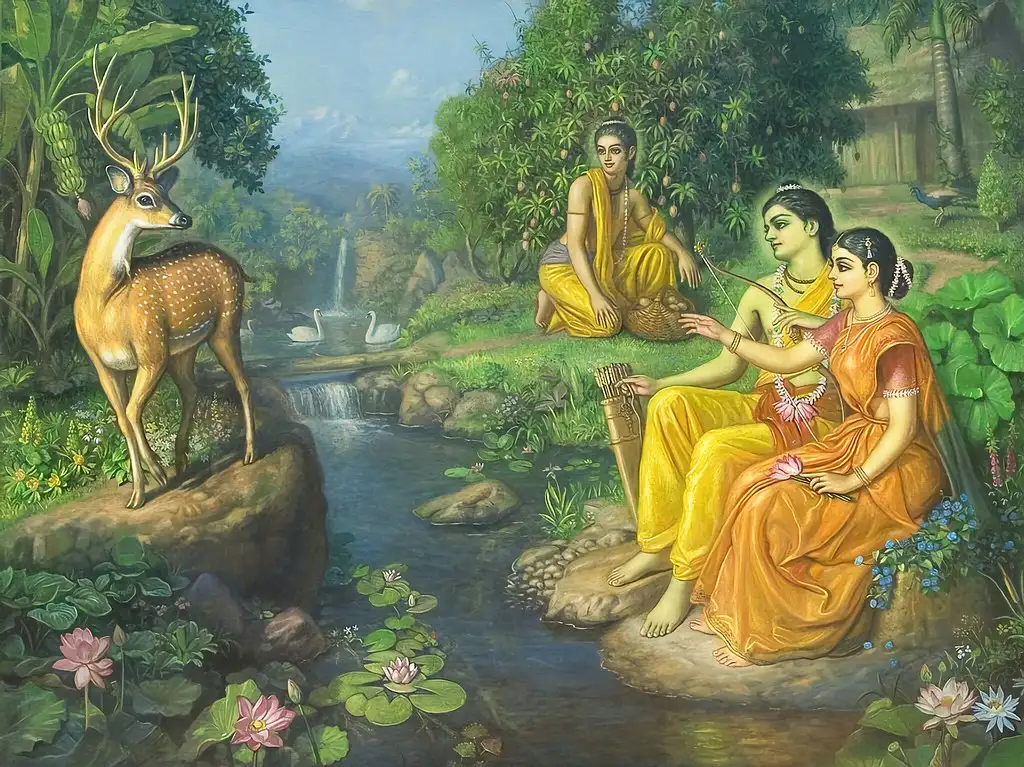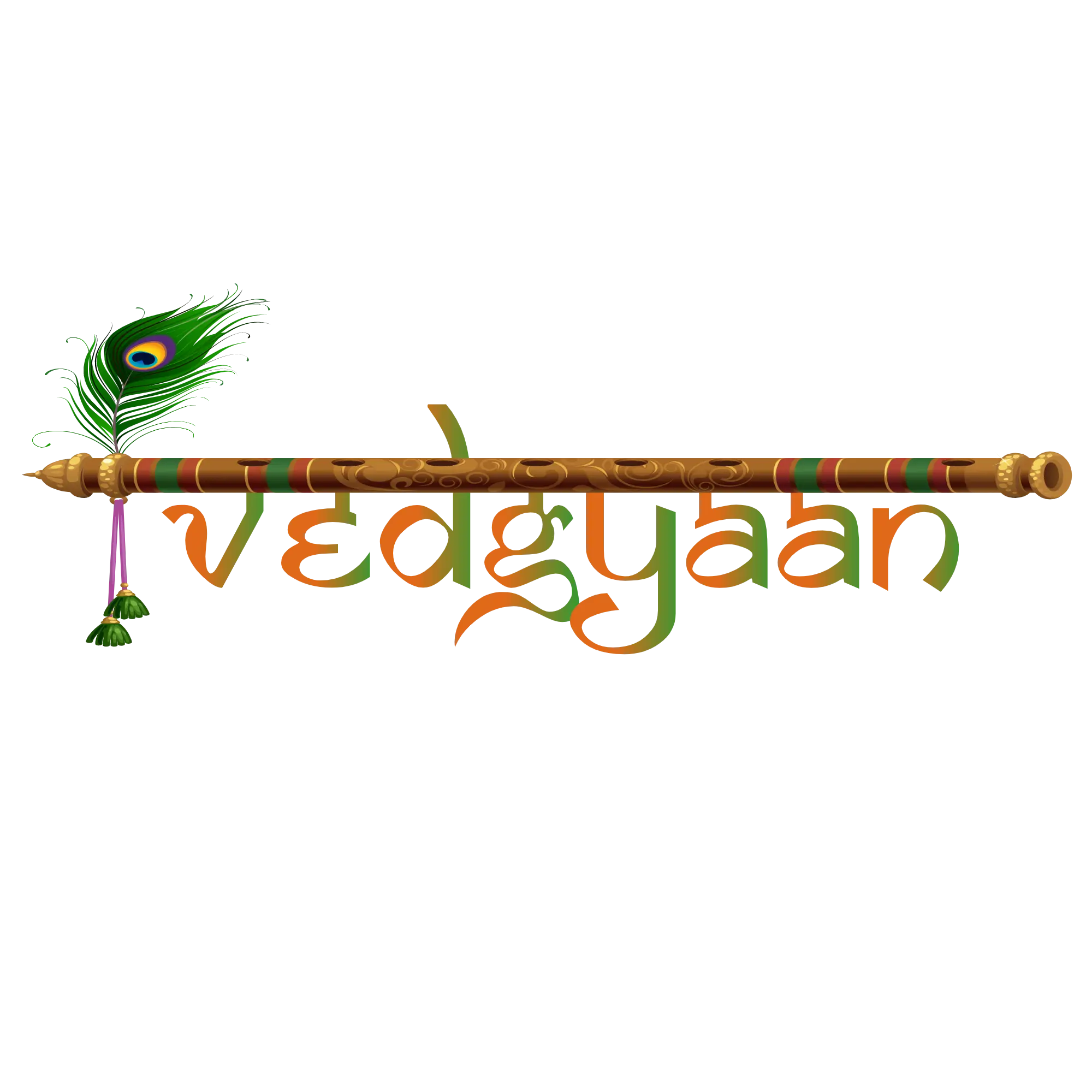Celebrate the Richness of Hindu Culture with Festivals! For thousands of years, Hindu festivals have been a source of joy, togetherness, and spiritual fulfillment. From commemorating the greatest moments in history to gathering with loved ones for grand celebrations, to offering prayers and worship to the Gods and Universe, these festivals are a true reflection of Hindu heritage and tradition. Experience the beauty, magic, and bliss of Hindu festivals and embrace the richness of Hindu culture.

(Public Domain)
January
Makar Sankranti
Makar Sankranti or Uttarayan is an annual festival celebrated in India and Bangladesh, celebrating the Hindu deity Surya, the Sun God. The main celebrations during this festival include kite flying, Surya Puja, dance, music, art, and Cow Puja.
Pongal
Pongal, also known as Thai Pongal, is a joyous celebration that marks the end of the harvest season in the southern part of India, particularly in the state of Tamil Nadu. This vibrant festival, which takes place over multiple days, is an opportunity for families and friends to come together and share in the abundance of the harvest. The centerpiece of the festivities is the preparation of a sweet dish known as Pongal, which is made from rice and milk and is then shared among loved ones. With its warm atmosphere, Pongal is a time for families to bond, reflect on the blessings of the past year, and look ahead with hope and anticipation to the year to come.
Basant Panchami
Basant Panchami, also known as Saraswati Puja, is an annual festival celebrated in India in honor of Goddess Saraswati, the Goddess of wisdom and knowledge. It also celebrates the arrival of Spring. The main festivities include social gatherings and Saraswati Puja.
February
Maha Shivaratri
Maha Shivaratri is a prominent festival in Hinduism celebrating Lord Shiva (God of Destruction), marking the day he performs his heavenly dance- The Tandava. Maha Shivaratri occurs between the months of February and March and is referred to as the “Great Night of Shiva”.
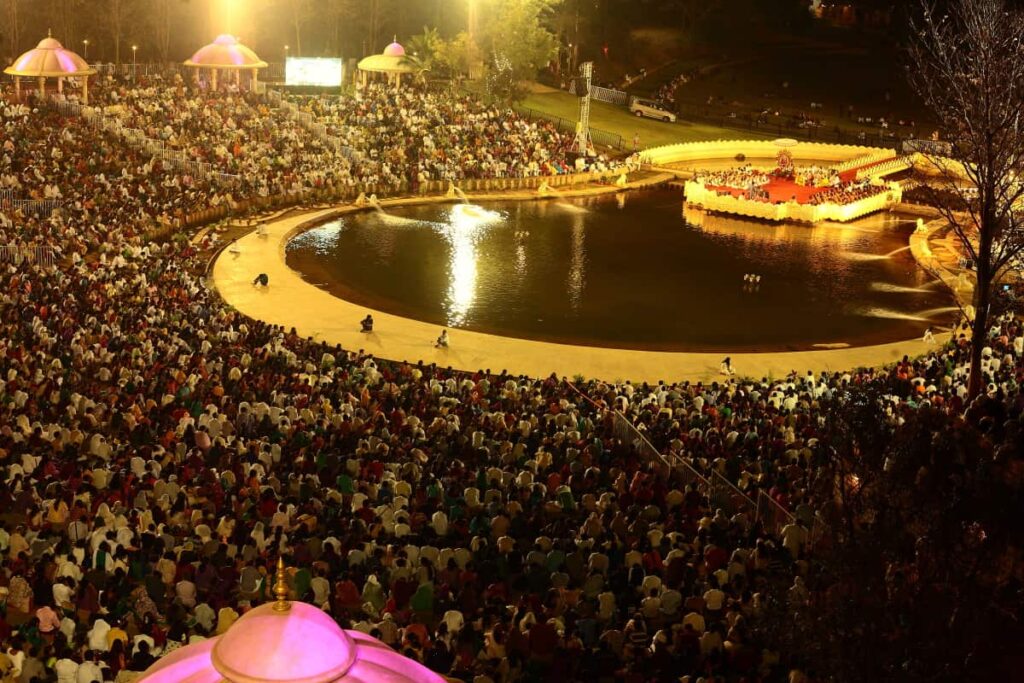
(Public Domain)
How is Mahashivaratri celebrated?
A significant Hindu festival, Maha Shivaratri is symbolic of overcoming darkness and evil and celebrating ethics and virtues.
The major traditions of Mahashivratri include fasting, chanting of prayers, meditation, and reciting stories depicting virtues such as honesty, kindness, benevolence, charity, and forgiveness – all intrinsic virtues of Lord Shiva. It also includes all-night vigils at temples, chanting to Lord Shiva. The Shiv Chalisa is recited all night long.
During Mahashivratri, the Shiva-Lingam is worshipped as a physical form of Lord Shiva and is celebrated and bathed with milk, and honey. The main aim of the festival is to celebrate the overcoming of ignorance and darkness in the universe.
March
Holi
Holi the Festival of Colors, is a vibrant and joyful festival celebrated mainly in India and Nepal. It is a celebration of spring and the triumph of good over evil, observed over two days in the month of March. During Holi, people smear each other with colored powders, dance, sing, and exchange sweets. The festival signifies the end of winter and the arrival of spring and is a celebration of new beginnings, friendship, and love. It is a time to let loose and have fun with loved ones, forget grudges, and start anew.
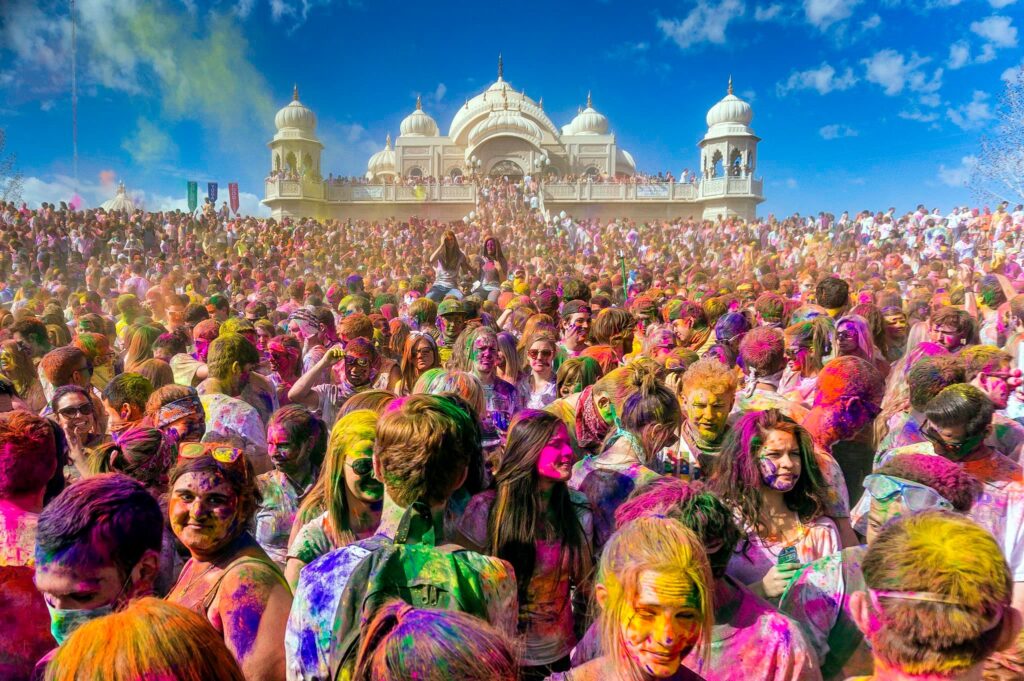
(Public Domain)
Origin of Holi
Holi is celebrated every year to commemorate the iconic love story of Lord Krishna and his lover, Radha. It is also celebrated as the festival of the triumph of good over evil as it marks the day Lord Vishnu assumed the form of the half-lion, half-man, Narasimha.
Holika Dahan
Legend has it that there was an evil king known as Hiranyakashipu. Known for his cruelty, Hiranyakashapu wreaked havoc on the earth during his reign. However, His son Prahalad was one of Lord Vishnu’s most devoted followers and refused to listen to his father.
Enraged by his actions, Hiranyakashapu concocted a plan to kill his son. His sister, Holika, possessed the power of being immune to fire, and hence, he enlisted her help to kill Prahalad.
Holika tricked Prahalad to sit with her on a burning pyre in the hopes of killing him. However, due to her wicked intentions, her immunity failed and she succumbed to the flames while Prahalad remained unscathed.
Since then, The first day of Holi has been celebrated as Holika Dahan, celebrating the triumph of Good over evil.
How is Holi celebrated?
The celebration of Holi centers around several rituals and joy-filled festivities such as –
Holika Pyre
The day before Holi, a large pyre is made out of wood and other materials and a large bonfire is lit. On top of the pyre, a large effigy of Holika is placed, signifying the defeat of evil.
Chhoti Holi
The first day of Holi involves gathering around the pyre and conducting pujas and other religious rituals, followed by lighting the pyre. To celebrate the victory of good over evil, devotees sing and dance around the burning pyre.
Badi Holi
On the second and most popular day of Holi, devotees gather in the streets and large open areas and celebrate by covering each other with different colors. Colored water, water balloons, and powdered color are used and devotees spend the day in joyous togetherness.
April
- Baisakhi
Baisakhi, also known as Vaisakhi, is an annual festival celebrated by Hindus and Sikhs to commemorate the beginning of the Hindu New Year. The main festivities include pujas, fairs, ritual bathing, and parades.
- Bihu
Bihu is an annual festival celebrated in India, mainly in the northeastern state of Assam. It is celebrated to commemorate the shifting of the Sun’s solstice. Bihu is celebrated by widespread art, dance, gatherings, puja, and music.
August
Rakshabandhan
Rakshabandhan, also known as Rakhi, is a festival celebrated by Hindus across India and other parts of the world. It is a celebration of the bond between siblings, where sisters tie a sacred thread, or Rakhi, on their brother’s wrist and pray for their well-being. Brothers, in turn, pledge to protect their sisters and present them with gifts. This festival is observed on the full moon day in the Hindu month of Shravana and is a time for families to come together, share meals and strengthen their bond. It is a celebration of love, protection, and siblinghood, and an occasion for families to express their love and appreciation for one another
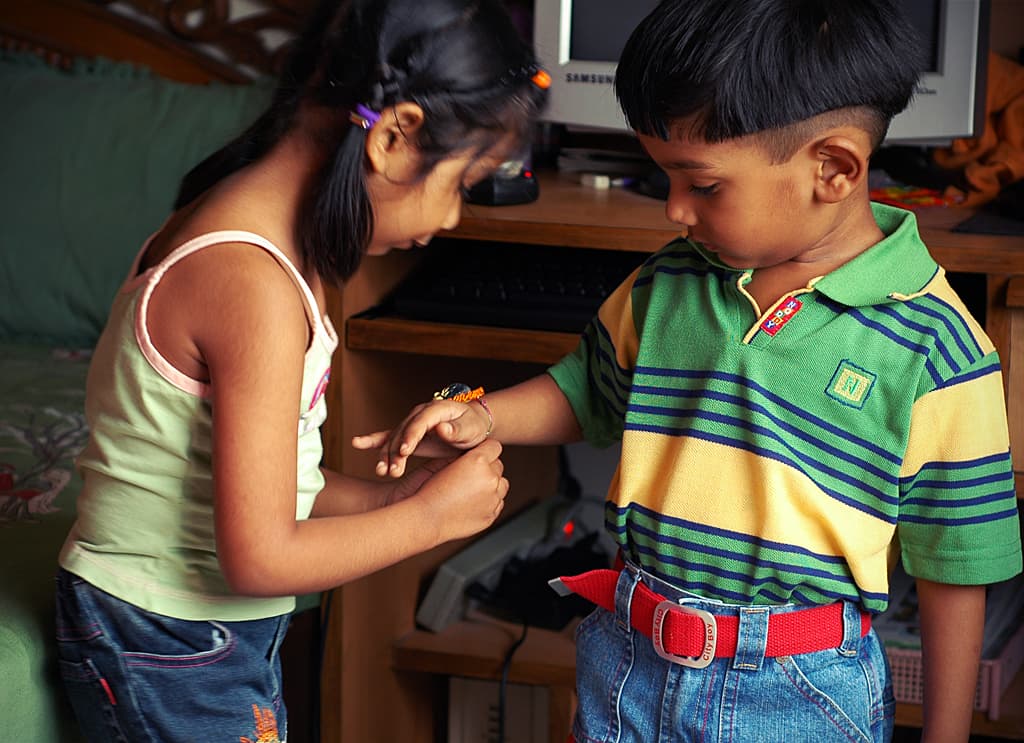
(Public Domain)
Ganesh Chaturthi
Ganesh Chaturthi or Vinayaka Chaturthi is the annual celebration of Lord Ganesha’s arrival on earth with Goddess Parvati, his mother. To show their devotion to Lord Ganesha and to celebrate his life and message, devotees practice a ten-day-long festival known as Ganesh Chaturthi.
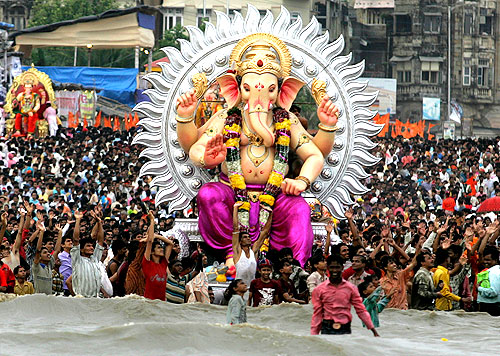
(Public Domain)
How is Ganesh Chaturthi celebrated?
Idols of Lord Ganesha are crafted and welcomed into temples and homes, and followers conduct pujas every day that the Ganesh idol is present in their homes. They pray to Ganesha to remove any obstacles in their lives and to bring prosperity to their homes.
The Ganesh idols are worshipped day and night and offerings of flowers, grass, and Modaks (an Indian delicacy) are presented to the idols. Every Puja ends with a special aarti (Hindu ritual) sung to please Lord Ganesha.
Ganesh Visarjan
On the tenth and final day of the festival, The Ganesh Idols are immersed in water, as a symbolic representation of allowing Ganesha to return to his celestial abode in a ceremony known as Visarjan.
It is believed that on the last day of the festival, Ganesha begins to make his way back to Mount Kailash to be with Lord Shiva and Parvati. The Ganesh Visarjan and his return to Mount Kailash are considered to be symbolic of the birth, death, and rebirth cycle.
As Ganesha is considered to be the destroyer of obstacles, devotees believe that immersing the Ganesh idols in the water is symbolic of destroying and ridding the obstacles in their lives.
Krishna Janmashtami
Krishna Janmashtami or Gokul Ashtami is the annual Hindu festival celebrating the birth of Lord Krishna, Lord Vishnu’s avatar. It occurs between August and September and is especially significant in the Hindu sect of Vaishnavism.
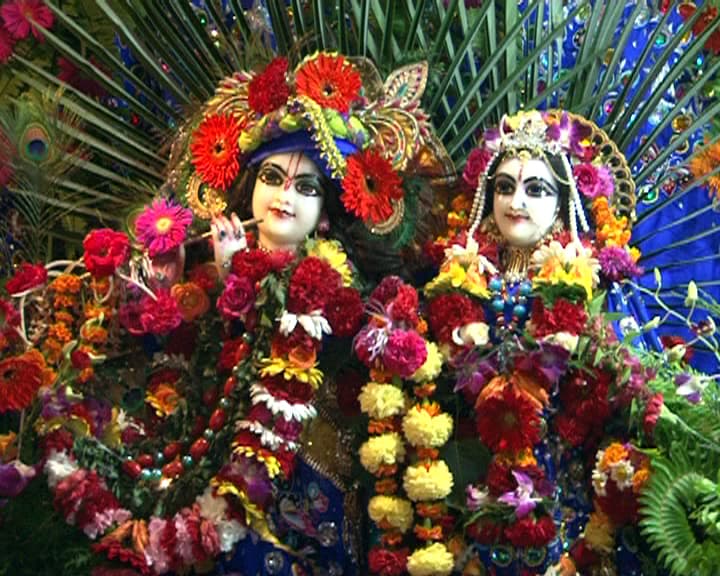
(Public Domain)
How is Janmashtami Celebrated?
During Janmashtami, Devotees conduct all-night vigils, fast, sing prayers, visit temples and prepare special feasts and offerings. Lord Krishna was born in an era where darkness was prevalent and was considered to be the savior. Hence, devotees try to honor his message of righteousness by placing special emphasis on ethics, virtues, and good behavior.
The Bhagavad Gita (The holiest Hindu text) is recited throughout the day and the Ras Leela – Lord Krishna’s divine dance with the milkmaids – is performed by devotees.
October
Navaratri
One of the most prominent Hindu festivals, Navaratri or Durga Puja spans over ten days and nine nights, celebrated between October and November. Navaratri is the festival or celebration of the divine feminine and involves the worship of nine goddesses over nine nights.

(Public Domain)
Origin of Navaratri
Navratri is celebrated annually by devotees far and wide to mark the anniversary of Goddess Durga’s grand victory over Mahishasura- the buffalo-headed demon.
It is believed that Mahishasura owned a boon from Lord Brahma– granting him immortality. However, there was a stipulation- Mahishasura could be killed by a woman.
When Mahishasura began to wreak havoc on the three worlds – heaven, hell, and earth – the Gods began to concoct a plan to defeat him. They approached Lord Shiva, who appealed to his wife, Goddess Parvati – the reincarnation of the divine feminine herself- to help.
Parvati incarnated herself as Goddess Durga, the warrior goddess blessed with the combined powers and weapons of the Gods. Durga charged into battle with Mahishasura, eventually killing him and ridding the world of evil.
Since then, Navaratri has been celebrated every year to commemorate Goddess Durga and her 9 forms.
How is Navratri celebrated?
Over the nine nights of Navratri, the 9 different forms of Goddess Durga are worshipped. Over the nine days, the legend of the great battle is recited, pujas are conducted, iconographies of the goddesses are erected and the sacred Hindu scriptures are recited.
Widespread cultural events like folk dances and songs are conducted and the harvesting of crops is celebrated. Devotees fast during these nine days to pay their respects.
Navaratri culminates in the day of Dussehra or Durga Puja, during which widespread pujas and celebrations of Goddess Durga are conducted. Large idols of the Goddesses are immersed in water bodies – symbolic of Goddess Durga returning to her celestial abode.
The nine days of Navratri
Day 1: Shailaputri
Pratipada marks the very first day of the Navaratri festival and is the celebration of the Shailaputri, the incarnation of Goddess Parvati, consort of Lord Shiva, and the daughter of the Himalayas. Shailaputri is the form of Parvati that carries a Trishul and rides Nandi- The divine vehicle of Lord Shiva.
The theme of this day is the color “grey”, symbolic of action, enthusiasm, and vigor.
Day 2: Brahmacharini
Dwitiya, The second day of Navaratri, celebrates the Goddess Brahmacharini – Parvati’s unmarried form or incarnation. On this day, devotees pray to Brahmacharini for salvation, as it is believed she is the bestower of Moksha (liberation of the soul).
Brahmacharini is depicted as a simple woman walking barefoot with a Japa mala (rosary) and water pot in hand. The embodiment of calm and blissfulness, Brahmacharini is said to bless devotees with prosperity and goodwill.
The theme of this day is the color “Orange” which depicts tranquillity, peace, and energy.
Day 3: Chandraghanta
On the third day, Tritiya, The Goddess Chandraghanta- Parvati’s form with the half-moon etched on her forehead. In this form, Parvati is depicted as a breathtaking young woman exuding bravery.
The theme of Tritiya is the color “white” which depicts purity, beauty, and vivaciousness.
Day 4: Kushmanda
Chathurthi is celebrated as the fourth day of Navaratri during which Goddess Kushmanda- an incarnation of Shakti (the primordial divine feminine, originator of the universe)- is worshipped. Kushmanda is depicted with 8 arms and riding on a tiger that bestows vegetation and life upon the earth.
The theme of Chaturthi is the color “Red” which depicts the earth and life.
Day 5: Skandamata
Panchami or the fifth day of Navaratri is associated with the worship of Parvati in the form of Skandamata- Kartikeya or Skanda’s mother. In this form, she is depicted as riding a lion with a ferocious look on her face and a baby in her arms.
The theme of this day is the color ”Royal Blue”, which is symbolic of a mother’s bond with her child.
Day 6: Katyayani
Shashti or the sixth day of Navaratri celebrates Katyayani, the most violent and vicious form of Goddess Durga. Katyayani is depicted as a vicious woman riding a lion.
The color of the day is “yellow”, which symbolizes courage.
Day 7: Kaalaratri
Saptami or the seventh day of Navaratri celebrates the most ferocious Goddess- Kali. With dark black skin, wild hair, and fierceness in her eyes, devotees worship Kali for protection.
The theme of the day is the color “green”, symbolic of Kali’s fierceness.
Day 8: Mahagauri
Ashtami or the eighth day is devoted to Gauri, the fair form of Parvati. It is believed that one day, Goddess Parvati shed her dark skin to reveal her fair-skinned form. Gauri is the embodiment of peace and intelligence.
Day 9: Siddhidhatri
Navami or the ninth day is devoted to Siddhidhatri – Durga’s final form. Siddhidhatri is depicted as sitting on a lotus, protecting nature and prolonging life. Siddhidhatri is the form of Parvati that forms the half-man, half-woman form of Lord Shiva.
The theme of this day is the color “Purple”, which depicts admiration and devotion to the beauty of nature.
Dussehra
Dussehra or Vijayadashmi is one of the most prominent Hindu festivals, which marks the end of Navaratri. Dussehra is widely celebrated as the end of Durga Puja, the end of Ramlila (the enactment of the events of the Ramayana), and the day that Arjuna defeated the Kaurava army in the great battle of
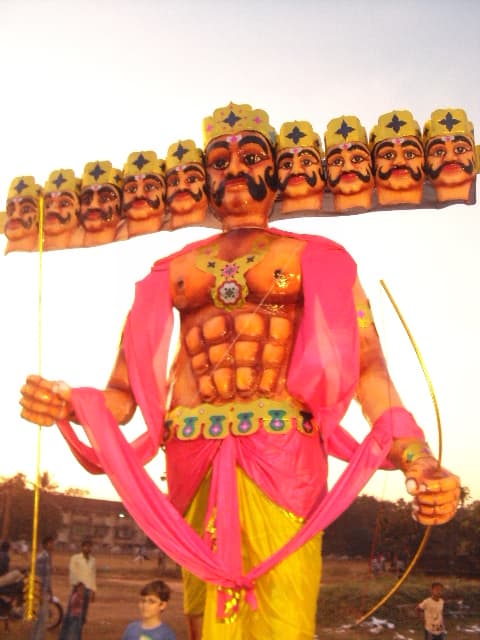
(Public Domain)
Origin of Dussehra
Rama’s Victory
In the events of the Ramayana, after Sita’s kidnapping, Lord Rama and his army made their way into Lanka, where a ground-breaking battle ensued between Rama and Ravana. In the end, Rama emerged victorious, killing the ten-headed Ravana – a feat that is known as Dussehra (killing of one with ten heads).
Ravana’s death established the restoration of Dharma on earth. Hence, Dussehra is widely celebrated as the victory of good over evil.
Arjuna’s Victory
Arjuna was one of the Pandavas, the royal princes of the Kuru Kingdom. The Pandavas had a long-standing rivalry with their first cousins, The Kauravas, over the throne of the Kuru Kingdom. This rivalry soon developed into a raging hatred, sparking the devastating battle that occurred in The Mahabharata ( a great Indian epic).
During the battle, Arjuna killed tens of thousands of his opponents single-handedly, proving that he is the greatest warrior of all time. Arjuna’s victory coincided with Rama’s victory and hence, Dussehra also came to be known as “Vijayadashami” (Arjuna’s Day).
How is Dussehra celebrated?
A ten-day-long festival, Dussehra sees the Ramayana and Ramlila enacted over ten days. Idols of Rama and Ravana are constructed and the battle between them is enacted. These idols of Ravana are soon burnt on the final day, symbolizing Rama’s victory.
Devotees gather in large outdoor areas to perform thousands of plays, music, and dances. The entire festival focuses on the theme “Good triumphs over evil”.
In the Kullu valley of Himachal Pradesh, a large parade boasting over half a million people is conducted, depicting Rama’s victory. In Southern India, Goddess Durga is worshipped as the remover of evil, and homes and temples are brightly lit up. In parts of western India such as Gujarat, Lord Rama and Goddess Durga are worshipped. Devotees often spend the festival praying and fasting. “Dandiya Raas” or “Garba” is a traditional dance that is performed with sticks during Dussehra to commemorate good over evil.
November
Diwali
Diwali, also known as the “Festival of Lights,” is one of the most significant Hindu celebrations. It takes place during October or November and commemorates the return of Lord Rama to Ayodhya after 14 years of exile. People decorate their homes with lights and candles, light firecrackers, and exchange gifts with friends and family. The festival symbolizes the victory of light over darkness and is celebrated with joy and enthusiasm by millions of people across India and the world.

(Public Domain)
Origin of Diwali
The origin of Diwali stems from the great Indian epic Ramayana – a tale of Lord Rama and his quest to rescue the love of his life and rid the world from the evil clutches of Ravan, the demon king of Lanka.
Lord Rama was first in line to the throne of Ayodhya and was married to Princess Sita, his great love. However, when it was Rama’s time to ascend the throne, his stepmother – under the influence of her evil maid – concocted a plan to snatch the throne from Rama and present it to her son, Bharata. Owing to a boon that was owed to her by her husband, the King, K got her wish and removed Rama from his position as crown prince and exiled him for fourteen years.
In a display of undying loyalty, Rama was accompanied by Sita and his brother Lakshmana on his laborious exile. During this exile period in the forest Sita caught the eye of the demon king Ravana and was kidnapped.
Sita’s kidnap sparked the greatest adventure of all time – Rama and Lakshmana’s quest to rescue her. With the help of the Vanara army and Hanuman, Lord Rama and his allies marched into Lanka and fought a great battle, emerging victorious.
Following her rescue, Sita, Rama, and Lakshmana returned to Ayodhya victorious, much to the delight of the people. They were welcomed and celebrated with lights and lamps – a tradition that soon came to be celebrated as Diwali, marking the anniversary of Rama’s return to Ayodhya.
In addition to this, Diwali is widely associated with Goddess Lakshmi, the Goddess of Prosperity and success. It is believed that Diwali marks the day that Lakshmi emerged from the ocean when the Gods and Demons were churning it to obtain Amrit – the nectar of immortality.
How is Diwali celebrated?
Diwali is celebrated for five days – with the third day signifying the main festival or celebration. Devotees adorn their houses and temples with lamps, candles, lanterns, and diyas, paying homage to how Lord Rama was welcomed back to Ayodhya.
The skies are often set alight by a vast array of fireworks and devotees draw eye-catching rangolis in their homes and temples. On the dawn of each day of this prominent festival, devotees take a ritual oil bath to remain pure throughout the day.
Diwali is often symbolic of reunion and homecoming, with families and friends gathering together to partake in celebrations and large feasts. A popular Diwali tradition, devotees often feed each other sweets and other delicacies in a display of love and togetherness.
The different days of Diwali
Diwali officially begins 20 days after Dussehra and is celebrated over five days. In one of the most significant Hindu festivals, Devotees begin to prepare for Diwali weeks in advance – performing rituals and celebrations up till the commencement of the festival.
Each day has a unique set of traditions and poojas that are followed by devotees far and wide.
Day 1: Dhanteras
The thirteenth day of the Hindu month of Kartik, Dhanteras, marks the beginning of Diwali. Devotees begin their preparations for the next five days, cleaning their homes and temples. Diyas and lanterns are erected all over the temples and houses and the floors and streets are adorned with rangoli designs.
Devotees offer prayers and conduct poojas to Goddess Lakshmi and Lord Ganesha and erect iconographies of Ganesha and Lakshmi. It also signifies the day of purchases, where devotees purchase new items for their homes and gifts for their families.
Day 2: Chhoti Diwali or Hanuman Puja
Chhoti Diwali or the day before Diwali is the day of prayer for salvation or liberation. On this day, Devotees worship the Gods to pray for their ancestors and those souls that are facing eternal suffering in the netherworld. Devotees also pray for the liberation of their souls and to be enlightened on the path of righteousness.
Chhoti Diwali is the day of the Hanuman Puja, where Lord Hanuman is worshipped by devotees for strength, protection, and courage. It is believed that on their great quest together, Lord Rama was so impressed with Lord Hanuman, that he blessed him and stated that Hanuman would always be worshipped before him. As a result, the Hanuman Puja is conducted before the main festival.
Day 3: Lakshmi Puja
On the main day of the five-day festival, devotees visit family and friends and gather together to share in the festivities. On this day, devotees partake in large feasts and often share sweets.
Women are adorned in new jewelry and pujas are conducted in honor of Goddess Lakshmi, Lord Rama, Goddess Saraswati, and Lord Ganesha. Diyas are lit and set adrift on lakes while devotees celebrate the night by lighting fireworks- symbolic of warding off evil spirits and bidding adieu to ancestral spirits.
The story of Ramayana is recited and there is a special emphasis on the concept “good is always victorious over evil”. Goddess Lakshmi is welcomed into the homes of devotees to bring prosperity and success into their lives.
Day 4: Annakut
The day after the main day, Annakut is the day that celebrates marital bonds and agriculture. On this day, Husbands shower their wives with gifts to celebrate their marriage.
Annakut is also the day of ‘Govardhan Puja’, a puja commemorating Lord Krishna’s great feat of lifting the Govardhan mountain to save the people from the wrath of Lord Indra.
Day 5: Bhai Duj
Bhai Duj or ‘Brother’s day’ is the final day of Diwali and celebrates the bond between a brother and a sister. On this day brothers travel to the sister’s abode to visit her and pay their respects, commemorating Lord Krishna’s arrival at his sister Subhadra’s house after defeating the evil Narakasura.
A feast is prepared and the sisters feed their brothers with sweets and fruits and receive gifts. Pujas are also conducted to prolong the relationship and for a long and healthy life.
Conclusion:
Hindu festivals play an integral role in Hinduism and are a testament to its rich cultural heritage and traditions. With origins dating back thousands of years, Hinduism is one of the oldest religions in the world and boasts the largest number of festivals. These festivals are not just an opportunity for Hindu communities to come together and celebrate, but they also serve as a reminder of the significance of Hindu beliefs, values, and traditions. Despite the passage of time, the celebration of Hindu festivals continues to this day, serving as a beacon of hope, happiness, and unity. These festivals hold a special place in the hearts of Hindus, and their celebration ensures that the rich cultural legacy of Hinduism is preserved for future generations to come.
